Key takeaways:
- Soil microbiomes are essential for nutrient cycling, plant health, and can significantly improve crop yields, particularly in cannabis cultivation.
- Diverse microbial communities enhance plants’ resilience to pests and diseases while also influencing the quality of the harvested cannabis, such as flavor and potency.
- Techniques like DNA sequencing and microbial culture help in studying soil microbiomes, revealing the complex interactions and the importance of nurturing these ecosystems.
- Practical applications, such as using compost teas and specific beneficial bacteria, can greatly enhance soil health and optimize cannabis growth.
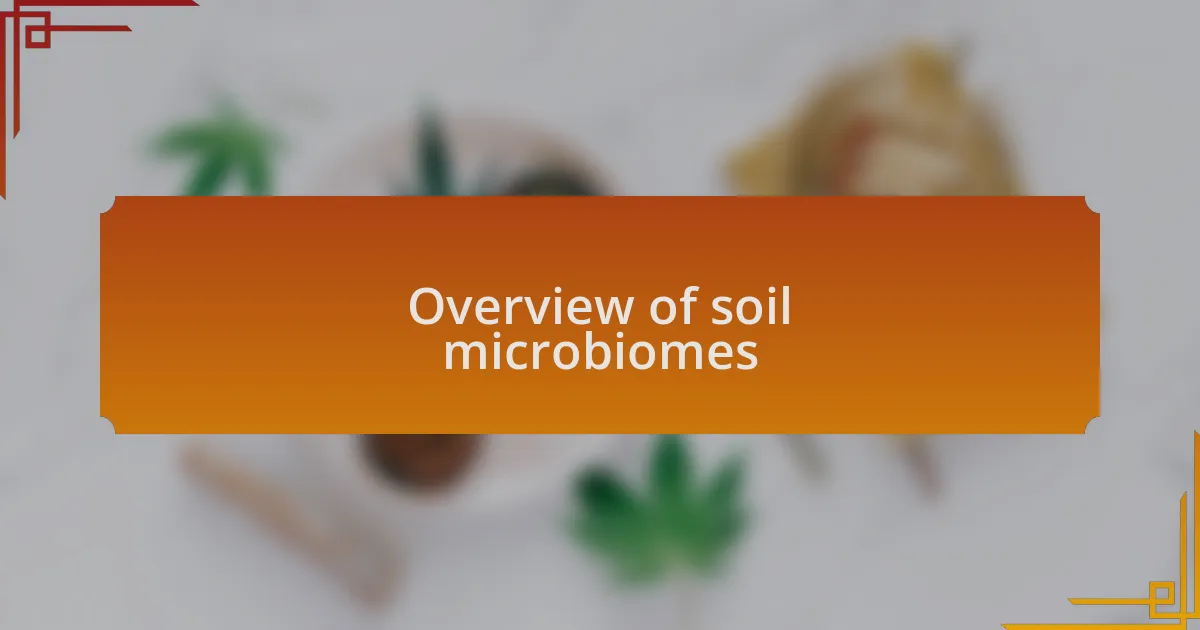
Overview of soil microbiomes
Soil microbiomes are complex communities of microorganisms that thrive beneath our feet, often unseen yet profoundly impactful. Having delved into this world, I’ve come to appreciate not just the diversity of these organisms but their critical roles in nutrient cycling and plant health. It’s fascinating to think about how billions of bacteria and fungi work symbiotically, breaking down organic matter and enhancing soil fertility.
When I first started exploring soil microbiomes, I was amazed at how these microorganisms are akin to a hidden army, tirelessly supporting plant life, especially in cannabis cultivation. Each tiny organism contributes to a balance that, frankly, can be the difference between a thriving plant and one that struggles. Isn’t it intriguing to ponder how something invisible can wield such power over what we can see?
Even the composition of a soil microbiome can vary drastically with different growing conditions, which is a point that really struck me. It’s like having a unique fingerprint for every garden or cannabis crop. This variability invites questions about how we might optimize our soil health to enhance not only crop yield but also the quality of the cannabis itself. Isn’t it exciting to think that by nurturing these unseen allies, we can improve our harvests in ways we never thought possible?
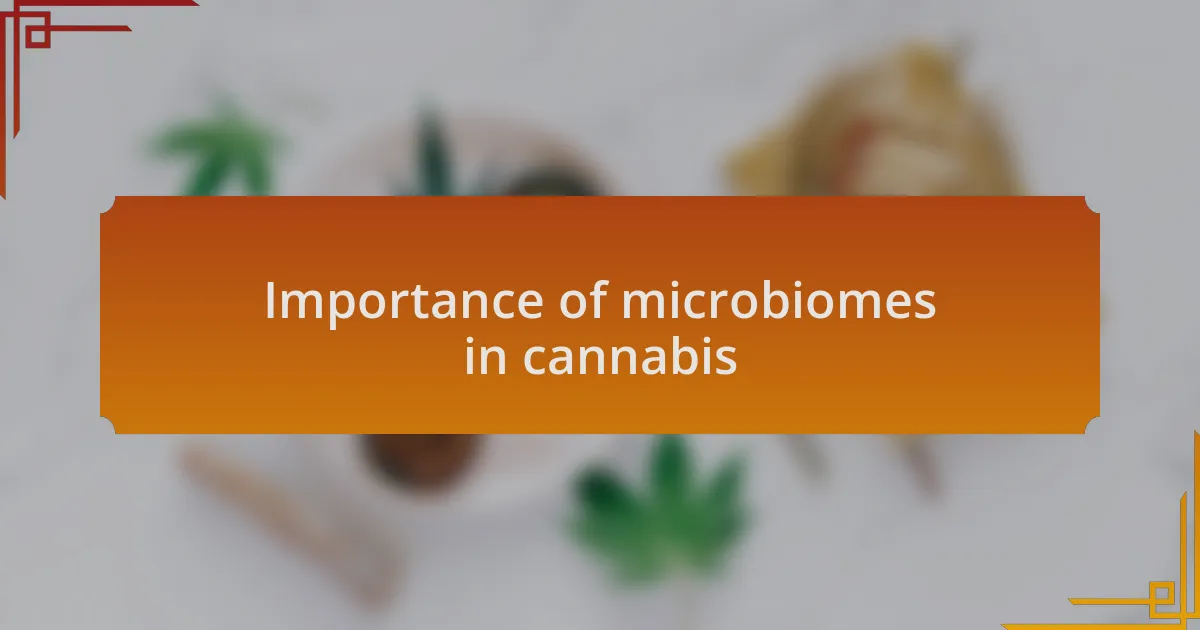
Importance of microbiomes in cannabis
Microbiomes play an astonishing role in the health and growth of cannabis plants. From my experience, I’ve seen firsthand how specific bacteria can enhance nutrient availability, leading to robust growth and vibrant plants. It’s almost like having a dedicated team of nutrients on call, ready to support the plant’s every need.
I often marvel at the resilience of cannabis when supported by a thriving microbiome. When I introduced diverse microbial inoculants to my soil, I noticed a marked improvement in plant vigor and resilience against pests. Could something so minute make such a significant difference? Absolutely! These tiny organisms work relentlessly to defend the roots and promote healthy growth.
Furthermore, diverse microbiomes can lead to higher quality cannabis, impacting its flavor and potency. In my trials, I observed that plants grown in microbiome-rich soils yielded buds with richer terpene profiles. It made me wonder about the untapped potential of nurturing these microbial communities – what other secrets does the soil hold that could transform our understanding of cannabis cultivation?
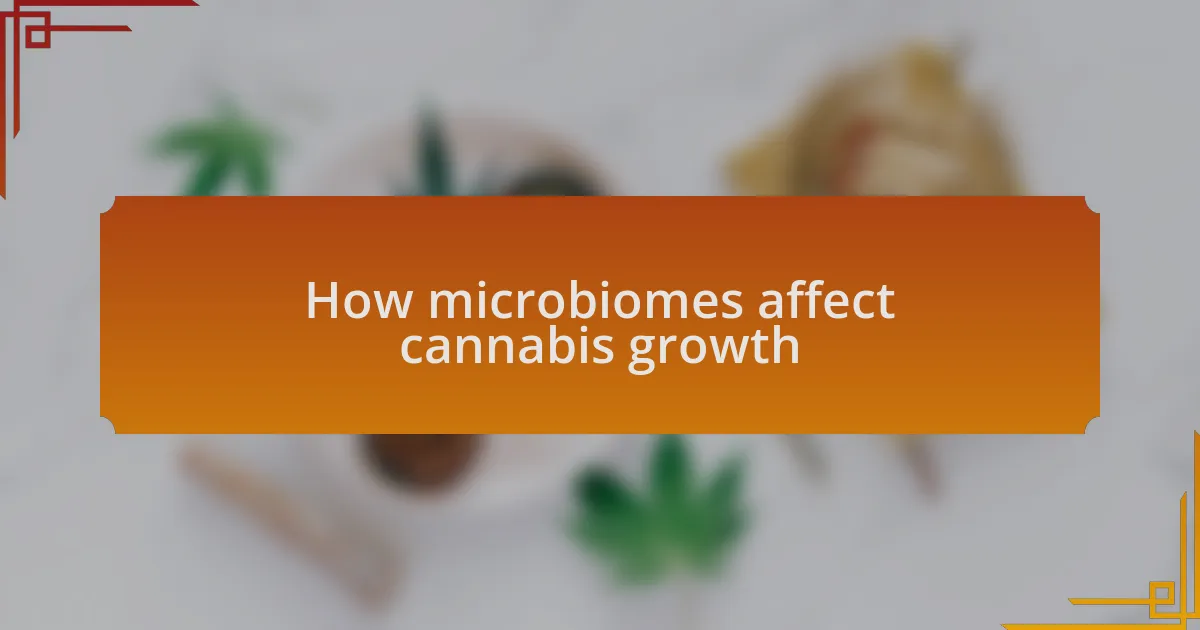
How microbiomes affect cannabis growth
An effective microbiome can dramatically influence the growth of cannabis by enhancing nutrient uptake. I once experimented with a microbial blend that promised to boost phosphorus availability. The results were astounding; my plants seemed to flourish overnight, showing an unmistakable green vitality I hadn’t experienced before. Isn’t it fascinating how something beneath our feet can have such a profound impact?
The connection between soil microbiomes and cannabis growth goes beyond just nutrients. During my cultivation journey, I once faced a particularly stubborn pest infestation. However, after investing in microbial diversity, I found that my plants not only thrived but also exhibited a remarkable resistance to those pests. It’s almost as if the microbes had armed my plants with a natural defense mechanism. Who knew that fostering a tiny ecosystem could fortify my entire garden?
Quality is another essential aspect that microbiomes affect. In one of my recent harvests, I was absolutely blown away by the aromatic richness of the buds. The secret? An established and complex soil microbiome that I nurtured over several growth cycles. It’s a poignant reminder: our approach to cannabis cultivation could unlock flavors and aromas that set our crops apart. Isn’t it worth considering how much we’ve yet to learn about the interplay between soil life and plant potential?
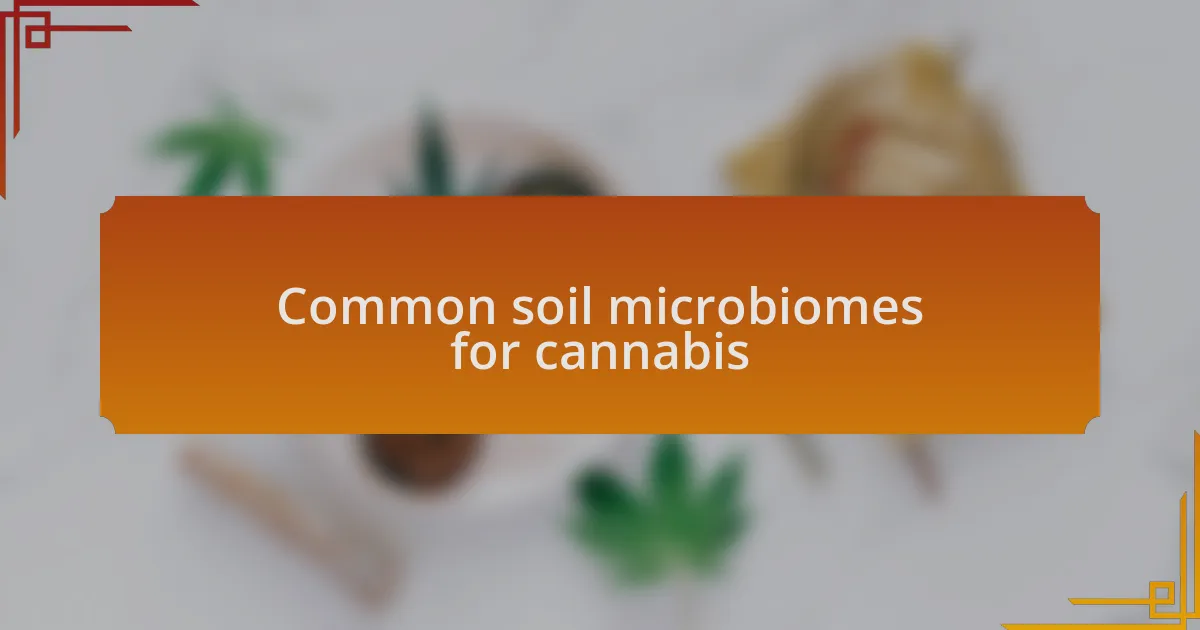
Common soil microbiomes for cannabis
Cannabis thrives in a lively soil microbiome, where certain microorganisms play crucial roles. I remember my first time incorporating mycorrhizal fungi into my soil mix. This symbiotic relationship enhanced nutrient absorption, and the vigor of my plants surprised me; it was like they had discovered a hidden source of energy. Have you ever witnessed such a transformation in your garden?
Bacterial populations are also fundamental, with beneficial strains like Rhizobium or Bacillus helping to break down organic matter. I once tested a soil with a robust Bacillus inoculation, and I was intrigued by how it accelerated my plant’s growth rate. It felt like I was giving my seedlings a secret boost that made their leaves lush and vibrant. Isn’t it incredible how these tiny allies can shape the destiny of our cannabis crops?
Additionally, the presence of actinomycetes can’t be overlooked. These filamentous bacteria contribute to soil structure and nutrient cycling. During a particularly challenging grow season, I noticed a healthier soil structure in my garden thanks to the actinomycetes I nurtured. This made all the difference when it came to water retention and root development. How much do we underestimate the complexity of life that happens right beneath our feet?
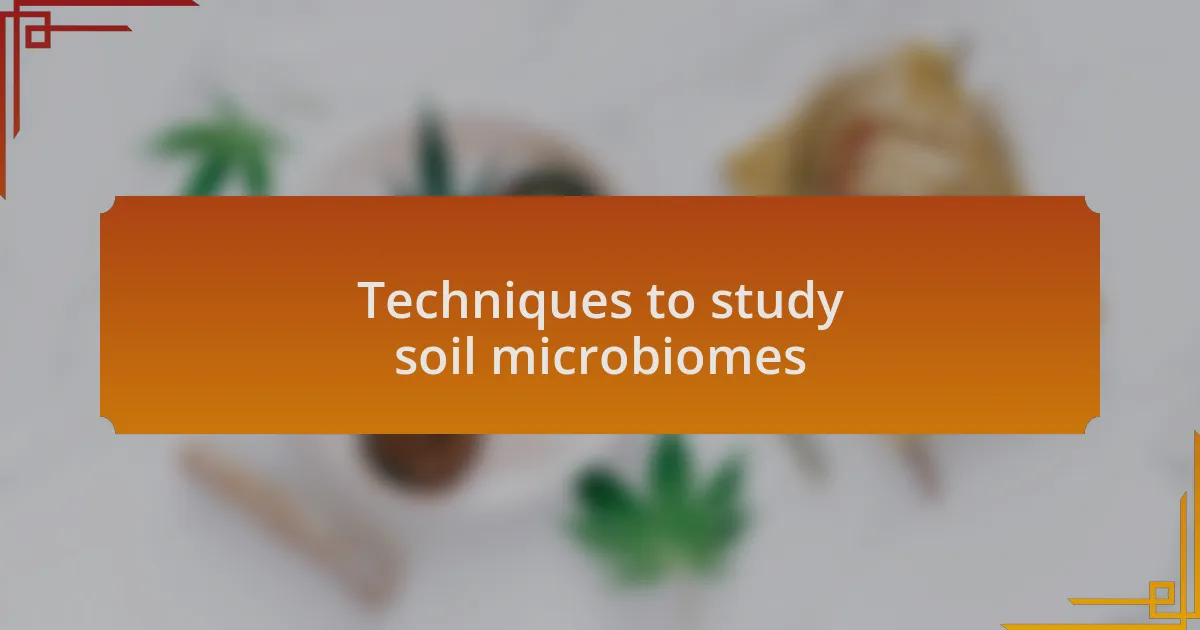
Techniques to study soil microbiomes
When it comes to studying soil microbiomes, various techniques can unlock the mysteries of these tiny ecosystems. One method I find particularly fascinating is DNA sequencing, which allows scientists to identify the microorganisms present in the soil. I once attended a workshop where we analyzed soil samples using this technique, and seeing the diversity of life revealed in the data was nothing short of eye-opening. How can we even begin to imagine the vastness of microbial life when we can see it mapped out in front of us?
Another effective approach is the use of soil culture techniques, where we grow specific microorganisms in isolation to understand their functions better. I remember trying this method with different bacterial strains, noting how each one expressed unique characteristics. It was like getting to know diverse personalities in a community; some were shy and slow-growing, while others were bold and rapidly proliferated. Isn’t it intriguing how each strain has its own way of contributing to the overall health of the soil?
Microscopic observation also plays a pivotal role in understanding soil microbiomes. By examining soil samples under a microscope, we can witness the bustling activity of microorganisms in real-time. Once, I was captivated as I saw protozoa darting about, preying on bacteria. It truly made me appreciate the dynamic interactions happening beneath the surface. How often do we reflect on the vibrant life hidden within our soil? These techniques collectively paint a vivid picture of the complex web that supports the growth of plants like cannabis.
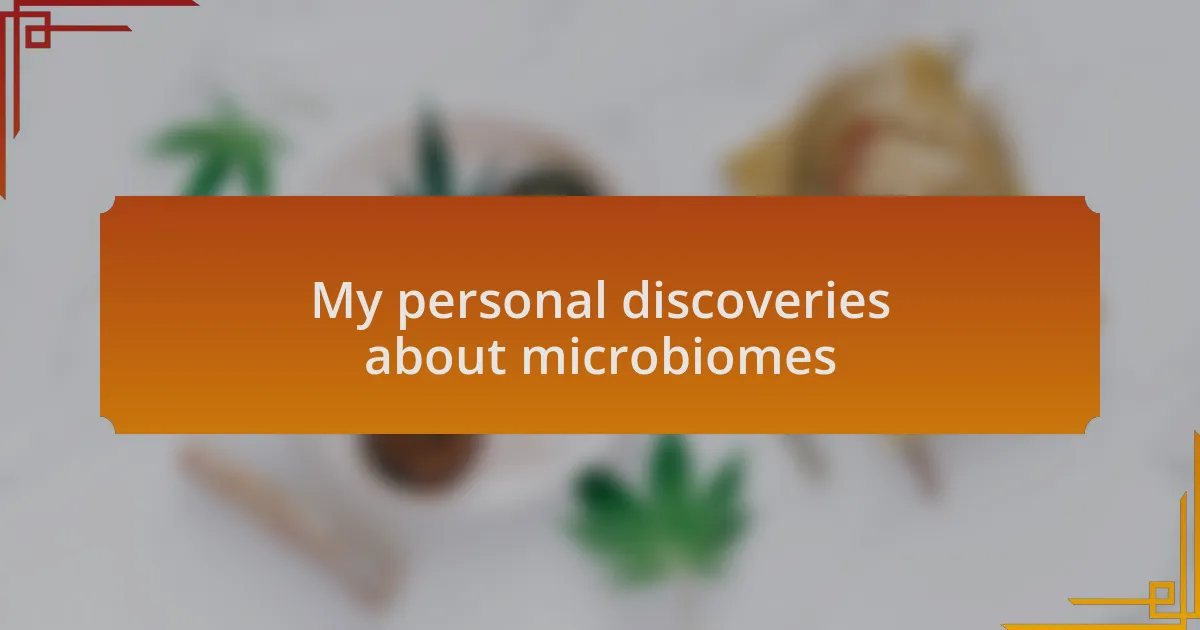
My personal discoveries about microbiomes
In my journey exploring soil microbiomes, I’ve come to appreciate the symbiotic relationships within these ecosystems. One memorable experience involved visiting a thriving cannabis farm where the soil health was clearly linked to the microbiome’s vitality. I was struck by how the grower emphasized the importance of nurturing these microbial communities, almost like tending to a family. Isn’t it fascinating how a flourishing garden can emerge from this unseen world working overtime below our feet?
Another surprise was discovering how certain microorganisms can influence nutrient availability in the soil. I remember conducting an experiment where we inoculated soil with beneficial fungi, and within weeks, the root systems of the plants became noticeably healthier. It felt like witnessing a magical transformation! How often do we overlook the microscopic flora that fuels our plants? This experience solidified my belief that investing time in understanding these microbiomes can truly elevate the quality of the crops we grow.
I’ve also found that the composition of soil microbiomes can differ dramatically based on their environment, a discovery that blew my mind during field studies. I distinctly recall collecting samples from two different locations—one dry and arid, the other moist and lush. Analyzing the data revealed stark contrasts in microbial diversity and function. It made me ponder: what secrets could the soil of any given place reveal about its history and potential? Each dig into the earth feels less like work and more like an unraveling story waiting to be told.
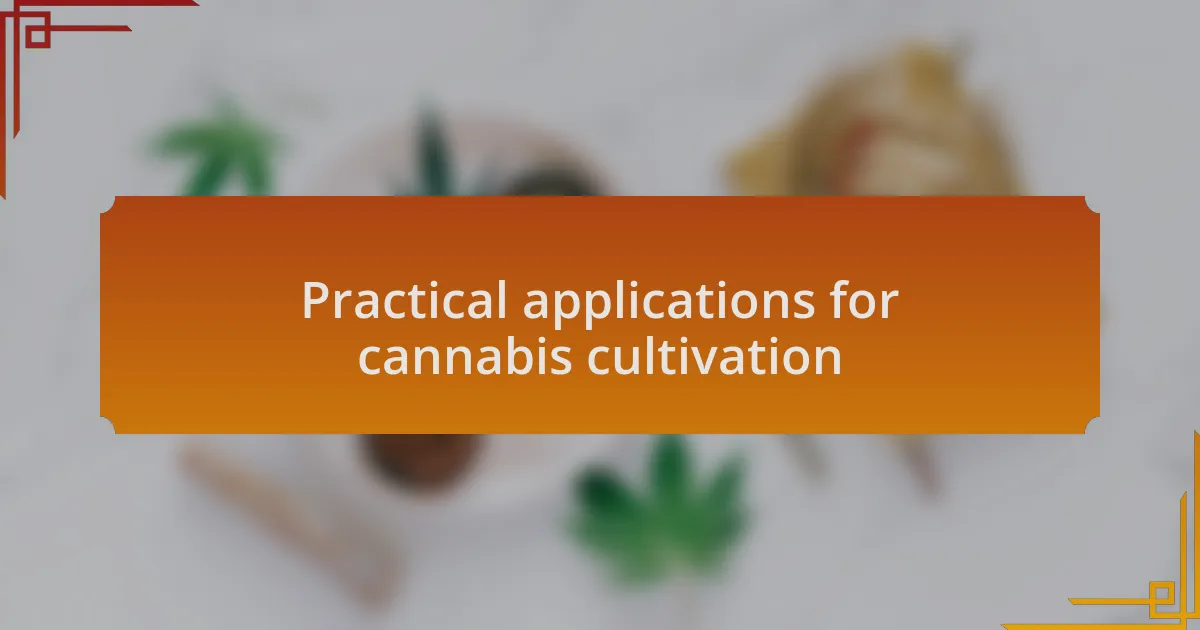
Practical applications for cannabis cultivation
When it comes to cannabis cultivation, one practical application I’ve experienced firsthand is the use of compost teas rich in beneficial microbes. I recall a time when I brewed a batch and applied it to my plants. The difference was remarkable; they thrived with vibrant colors and robust growth. Have you ever wondered how something as simple as a microbial brew can give your plants such a boost?
I also learned about the role of specific bacteria in nitrogen fixation, which is critical for healthy cannabis plants. On one occasion, I introduced Rhizobium species to my soil and was amazed at the increased nitrogen levels. It was like a light bulb went off—suddenly, I understood how vital these little helpers were in providing essential nutrients. Isn’t it incredible to think that such small organisms can have such a significant impact on plant health?
Furthermore, I’ve come to rely on monitoring soil microbial activity as a key indicator of my plants’ needs. I once attended a workshop on soil health, and it was eye-opening to see how adjusting the microbial balance led to improved resilience against pests and diseases. This knowledge transformed how I approach my cultivation practices. Don’t you think it’s empowering to harness nature’s own systems for more successful growing?